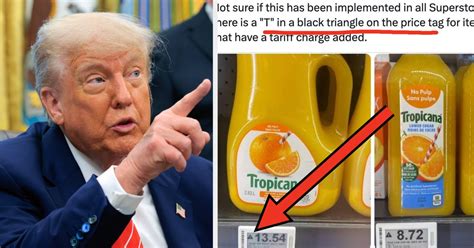
Tariffs are impacting American consumers directly, as evidenced by a viral social media trend where individuals share grocery receipts showcasing price increases, sparking debate about the true cost of trade policies.
The online campaign, fueled by rising food costs, has seen Americans posting photographic evidence of escalating prices at grocery stores, attributing the increases to tariffs implemented on imported goods. These anecdotal examples are triggering a wider discussion about the tangible effects of trade disputes on household budgets.
The Yahoo Finance article that spurred the movement focuses on increased consumer angst over rising prices, particularly in the grocery sector. The original article highlighted that “Americans are feeling the pinch,” and the “receipts going viral” phenomenon is a direct manifestation of this sentiment.
The price hikes are especially noticeable in everyday staples. Consumers are reporting significant increases in the prices of produce, meats, and dairy products, leading to increased concern about affordability. These price increases are raising questions about the economic impact of tariffs and their contribution to inflationary pressures.
One shopper expressed their frustration, stating, “It’s not just a few cents here and there; it’s adding up significantly each week. We’re having to make tough choices about what to buy.” This sentiment is echoed across the viral posts, painting a picture of constrained budgets and difficult trade-offs. The public outcry is primarily because the price increases directly affect basic necessities.
The online backlash reflects broader concerns about the potential for tariffs to erode purchasing power and disproportionately affect lower-income households. Several posts question the long-term economic consequences of the current trade policies and whether the benefits outweigh the costs for average consumers.
While some economists argue that the impact of tariffs is complex and multifaceted, the viral receipt trend is making the issue more accessible and relatable for ordinary Americans. The debate is no longer confined to economic journals and political speeches; it’s playing out in real-time on social media, with consumers sharing their own experiences.
The underlying tension lies in the potential for tariffs to drive up inflation, thereby reducing real wages and disposable income. Economists are carefully monitoring inflation rates to determine the extent to which tariffs are contributing to broader price increases. If inflation continues to rise, it could prompt the Federal Reserve to take action, such as raising interest rates, which could further dampen economic growth.
Furthermore, businesses are also feeling the pressure of tariffs. Many companies are facing higher costs for imported raw materials and components, forcing them to either absorb the costs or pass them on to consumers. This can create a ripple effect throughout the economy, impacting everything from manufacturing to retail.
The viral receipts also highlight the interconnectedness of the global economy. Tariffs, intended to protect domestic industries, can disrupt supply chains and lead to unintended consequences, such as higher prices for consumers. The experience of Americans now, with a viral pushback, shows a real shift in perspectives on trade policies and consumer understanding.
Beyond the immediate price increases, there are also concerns about the potential for retaliatory tariffs from other countries. If other nations impose tariffs on American goods, it could harm U.S. exporters and further dampen economic growth.
The situation is evolving, and the long-term impact of tariffs remains uncertain. However, the viral receipt trend underscores the importance of understanding the potential consequences of trade policies on American consumers. The collective effort of these shared receipts is a potent reminder that economic policies have real-world implications for everyday people. The discussion continues to grow, fueled by real-world experiences and shared anxieties regarding the increasing cost of living.
The trend also brings up questions of who ultimately bears the burden of tariffs: importers, exporters, or consumers. Traditional economic theory suggests that the burden is often shared, but the viral receipts indicate that consumers are feeling a significant portion of the impact.
It also raises the question of whether the intended benefits of tariffs, such as protecting domestic industries, are worth the cost to consumers. The debate over this trade-off is likely to continue, especially as more data becomes available on the economic effects of tariffs.
The discussion extends beyond groceries, with concerns about the potential impact on other sectors, such as electronics, automobiles, and apparel. These industries rely heavily on global supply chains, and tariffs could significantly increase the cost of these goods for American consumers.
The trend raises questions about the effectiveness of tariffs as a policy tool. While tariffs may be intended to address trade imbalances or protect domestic industries, they can also have unintended consequences, such as higher prices for consumers and disruptions to global supply chains.
The viral receipts are serving as a catalyst for a broader discussion about trade policy and its impact on American households. As the debate continues, it’s essential to consider the perspectives of all stakeholders, including consumers, businesses, and policymakers.
The situation underscores the need for careful consideration of the potential consequences of trade policies and the importance of finding solutions that benefit all Americans. It demands transparency and accountability in policymaking, ensuring that the interests of consumers are considered.
Furthermore, the debate is not limited to economic considerations. There are also political and social dimensions to the issue. The viral receipts are a reflection of a broader sense of economic insecurity and frustration among some Americans, which could have implications for future elections and policy debates.
The movement shows the power of social media to amplify consumer concerns and hold policymakers accountable. The viral trend is a reminder that ordinary people can play a significant role in shaping public discourse and influencing policy decisions. It demonstrates the impact a connected populace can have on demanding transparency and creating a more informed understanding.
The receipts, in their simple format, are potent statements, representing lived experiences and frustrations, and it demonstrates that abstract economic theories can have very tangible consequences for individuals and families.
Beyond the economic effects, the tariffs raise questions about the future of globalization and the role of the United States in the global economy. The current trade policies represent a shift away from multilateralism and towards bilateral agreements, which could have significant implications for international relations and global economic stability.
The viral receipts are a sign that Americans are becoming increasingly aware of the global interconnectedness of the economy and the potential impact of trade policies on their daily lives. The receipts serve as a wake-up call, demonstrating the critical necessity for the government to address these economic vulnerabilities.
Furthermore, the situation highlights the importance of financial literacy and empowering consumers to make informed decisions about their spending. As prices rise, consumers need to be able to understand the factors driving those increases and make choices that are in their best interests.
The viral receipts also underscore the importance of supporting local businesses and producers. By purchasing locally made goods, consumers can help to insulate themselves from the effects of tariffs and support their communities.
The trend is more than just a fleeting social media phenomenon. It reflects a deep-seated concern among Americans about the rising cost of living and the potential impact of trade policies on their financial well-being. It represents a tangible representation of public outcry about policies that directly and negatively impact the financial stability of average citizens.
As the debate over tariffs continues, it’s essential to remember that the ultimate goal should be to create a strong and prosperous economy that benefits all Americans. This requires finding trade policies that are both effective and equitable, and that take into account the needs of consumers, businesses, and workers.
The shared experiences are shaping a more informed electorate, with citizens demanding greater transparency and accountability from their elected officials. It signals a shift in public consciousness, with Americans becoming more attuned to the potential consequences of trade policies on their daily lives.
The viral receipts are a stark reminder that economic policies have real-world consequences and that the voices of ordinary people matter. It highlights the power of collective action and the importance of engaging in informed discussions about the issues that affect us all.
The viral trend should encourage more people to participate in public discourse and demand accountability from policymakers. It is through informed and engaged citizenship that we can create a more just and equitable society.
The discussion surrounding these viral receipts is also influencing the narrative of economic policy in the media. News outlets are increasingly reporting on the impact of tariffs on American consumers, which is helping to raise awareness and inform public debate.
The receipts are sparking conversations about the role of government in regulating the economy and protecting consumers. As Americans grapple with the rising cost of living, they are increasingly looking to policymakers for solutions.
The viral receipts are a testament to the power of ordinary people to shape public discourse and influence policy decisions. By sharing their experiences and demanding accountability, they are helping to create a more informed and engaged citizenry.
In conclusion, the viral receipt trend is a powerful reminder that economic policies have real-world consequences for ordinary people. The shared experiences are reshaping public discourse, influencing the media narrative, and demanding greater accountability from policymakers. As the debate over tariffs continues, it’s essential to remember that the ultimate goal should be to create a strong and prosperous economy that benefits all Americans.
Frequently Asked Questions (FAQs):
1. What are tariffs and how do they work?
Tariffs are taxes imposed on imported goods. They are typically levied by a country’s government on goods entering its borders from another country. The purpose of tariffs can vary, including protecting domestic industries, raising revenue for the government, or influencing trade relations with other countries. When a tariff is imposed, the price of the imported good increases, making it more expensive for consumers and businesses to purchase. This can lead to a decrease in demand for the imported good and a potential increase in demand for domestically produced alternatives. “Tariffs just got real,” the Yahoo Finance article highlights, which means that the policies once abstract are now impacting the consumers’ pockets and are much more apparent than before.
2. Why are Americans sharing grocery receipts on social media?
Americans are sharing grocery receipts on social media to highlight the rising prices of food and other goods, which they attribute to tariffs imposed on imported products. This trend, fueled by the “tariff receipts go viral” phenomenon, is a form of protest against trade policies that they believe are hurting consumers. By sharing their receipts, individuals are attempting to demonstrate the tangible impact of tariffs on their household budgets and raise awareness about the issue. The public outcry is primarily because the price increases directly affect basic necessities.
3. What types of products are most affected by tariffs, according to the viral receipts?
The viral receipts primarily highlight increased prices for everyday staples such as produce, meats, and dairy products. These are essential items that consumers purchase regularly, making the price increases more noticeable and impactful. The receipts also sometimes reflect higher prices for imported goods like certain fruits, vegetables, and processed foods, depending on the specific tariffs in place. The fact that these price increases are appearing in essential items has particularly contributed to the public anger and concern. The prices are “adding up significantly each week,” according to one concerned shopper.
4. How might tariffs impact the overall economy, beyond just grocery prices?
Beyond grocery prices, tariffs can have a ripple effect throughout the economy. They can increase the cost of imported raw materials and components for businesses, leading to higher production costs. This can force businesses to either absorb the costs, potentially impacting their profitability, or pass them on to consumers in the form of higher prices for goods and services. Furthermore, tariffs can lead to retaliatory measures from other countries, resulting in decreased exports and harm to domestic industries that rely on international trade. This can slow down economic growth and potentially lead to job losses. Economists are monitoring inflation rates to determine the extent to which tariffs are contributing to broader price increases.
5. What are some potential solutions or alternatives to tariffs that could address trade imbalances or protect domestic industries?
There are several potential solutions or alternatives to tariffs that could address trade imbalances or protect domestic industries:
-
Negotiating Trade Agreements: Engaging in negotiations with other countries to establish fair and mutually beneficial trade agreements can help to reduce trade barriers and promote economic cooperation.
-
Strengthening Domestic Industries: Investing in education, infrastructure, and research and development can help to strengthen domestic industries and make them more competitive in the global market.
-
Addressing Unfair Trade Practices: Working with international organizations like the World Trade Organization (WTO) to address unfair trade practices, such as subsidies or intellectual property theft, can help to level the playing field for domestic businesses.
-
Providing Support for Displaced Workers: Offering training and support programs for workers who are displaced by trade policies can help them transition to new jobs and industries.
-
Currency Manipulation Monitoring: Implementing measures to monitor and address currency manipulation by other countries can help to prevent unfair trade advantages.
These alternatives represent a more collaborative and strategic approach to addressing trade issues, focusing on long-term solutions that benefit both domestic industries and consumers.
6. Are there any benefits to tariffs for the U.S. economy?
While the viral trend focuses on the negative impacts, some argue that tariffs can have potential benefits. Proponents suggest tariffs can protect domestic industries from foreign competition, allowing them to grow and create jobs. They can also generate revenue for the government, which can be used to fund public services or reduce other taxes. Additionally, tariffs can be used as a bargaining chip in trade negotiations, giving the U.S. leverage to secure more favorable trade deals. However, economists often debate whether these potential benefits outweigh the costs to consumers and the overall economy.
7. How do tariffs affect small businesses compared to large corporations?
Tariffs can disproportionately affect small businesses compared to large corporations. Large corporations often have more resources to absorb the costs of tariffs or to find alternative supply chains. Small businesses, on the other hand, may have limited options and may be forced to pass the increased costs on to consumers, potentially making them less competitive. Small businesses are also less likely to have the resources to navigate the complex regulations and paperwork associated with tariffs. The viral receipts primarily highlight increased prices for everyday staples which directly affects small businesses.
8. What is the role of the government in regulating trade and protecting consumers?
The government plays a crucial role in regulating trade and protecting consumers. It sets trade policies, negotiates trade agreements, and enforces trade laws. The government also has a responsibility to ensure that consumers have access to safe and affordable goods and services. This can involve regulating prices, setting quality standards, and providing consumer education. The role of the government in regulating trade and protecting consumers is a complex and evolving issue, and there is often debate about the appropriate balance between these two objectives.
9. What are some ways consumers can mitigate the impact of tariffs on their household budgets?
Consumers can take several steps to mitigate the impact of tariffs on their household budgets. They can shop around for the best prices, look for sales and discounts, and consider buying generic brands. Consumers can also reduce their consumption of imported goods and support local businesses and producers. Additionally, consumers can become more informed about trade policies and advocate for changes that they believe will benefit them. This might involve contacting their elected officials, participating in public debates, or supporting organizations that advocate for consumer rights.
10. What are the long-term implications of the current trade policies for the U.S. and its trading partners?
The long-term implications of the current trade policies are uncertain, but they could be significant. If tariffs remain in place for an extended period, they could lead to a decrease in international trade, slower economic growth, and higher prices for consumers. They could also damage relationships between the U.S. and its trading partners, potentially leading to further trade disputes and instability. It’s also possible that the current trade policies could lead to a restructuring of global supply chains, as businesses seek to avoid tariffs by relocating production to other countries. This could have long-term implications for the U.S. economy and its role in the global marketplace.









